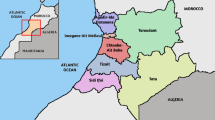Abstract
The prevalence of genetic diseases and congenital malformation in the Israeli Arab community is relatively high, but its distribution is not uniform. The aim of this study was to estimate the frequency of mental retardation disorders in children living in 5 Israeli Arab villages and determine its association with consanguinity. Mental retardation was found to affect 300 children in the screened population, yielding an overall prevalence of 14.5 per 1000. Most of those affected (68%) were the offspring of consanguineous marriages. One village with a high prevalence (4.3%) of neurological hereditary diseases was studied in detail. The prevalence of neurological hereditary diseases and mental retardation associated with consanguinity in these children highlights the need to implement appropriate preventive program.
Similar content being viewed by others
References
Zlotogora J., Genetic disorders among Palestinian Arabs: 1. Effects of consanguinity, Am. J. Med. Genet., 1997, 68, 472–475
Bener A., Hussain R., Teebi A.S., Consanguineous marriages and their effects on common adult diseases: studies from an endogamous population, Med. Princ. Pract., 2007, 16, 262–267
Teebi A.S., Teebi S.A., Genetic diversity among the Arabs, Community Genet., 2005, 8, 21–26
Jaber L., Merlob P., Bu X., Rotter J.I., Shohat M., Marked parental consanguinity as a cause for increased major malformations in an Israeli Arab community, Am. J. Med. Genet., 1992, 44, 1–6
Zlotogora J., Haklai Z., Rotem N., Georgi M., Berlovitz I., Leventhal A., Amitai, Y., Relative prevalence of malformations at birth among different religious communities in Israel, Am. J. Med. Genet., A, 2003, 122, 59–62
Sharkia R., Zaid M., Athamna A., Cohen D., Azem A., Zalan A., The changing pattern of consanguinity in a selected region of the Israeli Arab community, Am. J. Hum. Biol., 2008, 20, 72–77
Zlotogora J., Molecular basis of autosomal recessive diseases among the Palestinian Arabs, Am. J. Med. Genet., 2002, 109, 176–182
Mental Retardation: Classification and Systems of Supports, American Association on Mental retardation, 2002, 10th edn, Washington.
McLaren J., Bryson S.E., Review of recent epidemiological studies of mental retardation: prevalence, associated disorders, and etiology, Am. J. Ment. Retard., 1987, 92, 243–254
Ropers H.H., Hamel B.C., X-linked mental retardation, Nat. Rev. Genet., 2005, 6, 46–57
Kleefstra T., Hamel B.C., X-linked mental retardation: further lumping, splitting and emerging phenotypes, Clin. Genet., 2005, 67, 451–467
Basel-Vanagaite L., Attia R., Yahav M., Ferland R.J., Anteki L., Walsh C. K., et al., The CC2D1A, a member of a new gene family with C2 domains, is involved in autosomal recessive non-syndromic mental retardation, J. Med. Genet., 2005, 43, 203–210
Santos C., Rodriguez-Revenga L., Madrigal I., Badenas, C., Pineda M., Mila M., A novel mutation in JARID1C gene associated with mental retardation, Eur. J. Hum. Genet., 2006, 14, 583–586
Basel-Vanagaite L., Taub E., Halpern G.J., Drasinover V., Magal N., Davidov B., et al., Genetic screening for autosomal recessive nonsyndromic mental retardation in an isolated population in Israel, Eur. J. Hum. Genet., 2007, 15, 250–253
Uyguner O., Kayserili H., Li Y., Karaman B., Nurnberg G., Hennies H. C., et al., A new locus for autosomal recessive non-syndromic mental retardation maps to 1p21.1–p13.3, Clin. Genet., 2007, 71, 212–219
Stromme P., Valvatne K., Mental retardation in Norway: prevalence and sub-classification in a cohort of 30037 children born between 1980 and 1985, Acta. Paediatr. 1998, 87, 291–296
Durkin M.S., Hasan Z.M., Hasan K.Z., Prevalence and correlates of mental retardation among children in Karachi, Pakistan, Am. J. Epidemiol. 1998, 147, 281–288
Kiely M., The prevalence of mental retardation, Epidemiol. Rev., 1987, 9, 194–218
Jaber L., Halpern G.J., Shohat T., Trends in the frequencies of consanguineous marriages in the Israeli Arab community, Clin. Genet., 2000, 58, 106–110
Author information
Authors and Affiliations
Corresponding author
About this article
Cite this article
Sharkia, R., Azem, A., Kaiyal, Q. et al. Mental retardation and consanguinity in a selected region of the Israeli Arab community. cent.eur.j.med 5, 91–96 (2010). https://doi.org/10.2478/s11536-009-0112-8
Received:
Accepted:
Published:
Issue Date:
DOI: https://doi.org/10.2478/s11536-009-0112-8



